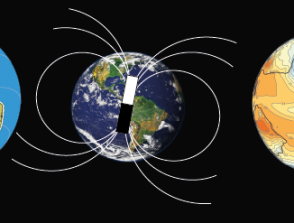Records of paleomagnetic field intensity in sediments : Crossover approach between relative paleointensity and cosmogenic ¹ºBe
Start: 01 October 2017
End: 20 July 2020
Supervisors :
Jean-Pierre Valet, Ramon Egli
Related teams :
Paleomagnetism Paleoclimate Environment (PAMCE)
Status: Defended
Doctoral dissertation – Tatiana Savranskaia
The direction and strength of geomagnetic field had been evolving continuously in the past. One of the few means of obtaining continuous reconstructions of this evolution relies on sedimentary records. The latter are therefore important for understanding the geodynamo and the underlying evolution of the Earth’s interior, as well as providing an important dating tool through magnetostratigraphy. Sedimentary records of geomagnetic field variations rely on two main recording mechanisms: the alignment of magnetic particles, which underlies continuous records of relative paleointensity (RPI), and the archivation of cosmogenic isotopes, in particular ¹⁰Be, whose production by cosmic ray spallation is modulated by the screening action of the dipole component of the Earth’s field. Previous studies reported similarities as well as significant differences between RPI and cosmogenic ¹⁰Be (expressed as ¹⁰Be/⁹Be) records. While a perfect match of the two records is not expected due to environmental contaminations present in both records, the similar changes during the periods characterised by significant decrease of the dipole moment are suggested owning to global field strength control of ¹⁰Be production and attenuation of non-dipolar features in RPI records measured within the sediments with the low sedimentation rates (<10 cm/ka). The aim of the present work was to improve our present knowledge on the field recording mechanisms of marine sediments, in particular: The environmental factors responsible for ¹⁰Be transport and removal from the water column, and the effect of source distributions on ⁹Be supply. The effect of post-depositional processes, in particular sediment mixing, on ¹⁰Be and RPI records. The mechanism by which a post-depositional magnetization is acquired near the bottom of the surface mixed layer. The causes of a systematic lag between ¹⁰Be and RPI records, and the environmental factors affecting RPI. In order to disentangle the environmental and magnetic contribution in sedimentary ¹⁰Be/9Be records, we analysed five records, covering the last geomagnetic reversal. Different recording characteristics at the five sites have been described in terms of additive and multiplicative climatic modulations, which depend essentially on water depth, location along large oceanic current systems, and distance to the coast. Simple criteria have been derived for the identification of most suited sites yielding minimal environmental contaminations. A new bioturbation model has been developed to explain sedimentary NRM in bioturbated sediment. This model includes a newly discovered phenomenon of size segregation in the surface mixed layer (SML), analogous to the well-known Brazil nut effect. Size segregation is responsible for the longer permanence of larger particles in the SML, up to the limit case of ferromanganese nodules and has important implications for sediment dating with benthic foraminifera. Calibration of the bioturbation model with microtektite profiles from two Indian Ocean cores enabled to reproduce the correct degree of delay between ¹⁰Be and RPI records, as well the environmental dependence of RPI in two cores from the North Atlantic and the Equatorial Pacific Oceans. The results obtained in this work can aid in developing integrated approaches for the correction of climatic contaminations in ¹⁰Be and RPI records. Furthermore, the predictive power of the bioturbation-based model for NRM acquisition can be used to design new laboratory experiments for the simulation of specific magnetic recording mechanisms. We have demonstrated the Brazilian-nut effect on the microtektite particles, that consists in size-dependent fragments segregation. The results of this research have significant importance not only for the sediment mixing response characterisation and reconstruction of affected by bioturbation processes records (e.g. ¹⁰Be /⁹Be),..





